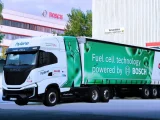
National Hydrogen and Fuel Cell Day Sparks Bipartisan Momentum for Green Hydrogen
October 14, 2025Igniting a hydrogen revolution in Washington
Picture yourself strolling past the Capitol’s marble columns on October 8th. Instead of lobbyists chit-chat, you’re hearing buzz about molecules, electrochemistry, and decarbonization. It was the 11th National Hydrogen and Fuel Cell Day, and the air was electric with excitement—journalists snapping photos at press events, curious minds exploring labs at the Department of Energy, and lively panels spiraling through congressional offices. Startup founders were demoing new electrolyzers while researchers unveiled slick, ultra-efficient fuel cell prototypes. Even bipartisan staffers were handing out brochures on the next wave of hydrogen hubs. The big applause came when Rep. Jim Costa (D-CA), Rep. John Larson (D-CT), Rep. Paul Tonko (D-NY) and Rep. David Valadao (R-CA) rolled out resolutions to officially stamp October 8 as the nation’s annual moment to supercharge clean energy innovation.
What’s the story behind 10/08?
It’s not just a calendar quirk—it’s hydrogen’s own chemistry punchline. With an atomic weight of 1.008, the date 10/08 has become synonymous with H₂. Since 2015, the Fuel Cell & Hydrogen Energy Association has rallied industry players and academia to mark this celebration. You’ll see governors in California and Connecticut signing proclamations, universities hosting student-built hydrogen car races, and coast-to-coast webinars spilling the tea on fuel cell tech. From live demos of fueling stations to deep dives into green hydrogen production, the event pulls back the curtain on how hydrogen fuel cells are set to decarbonize everything—urban transit, heavy industry, you name it.
Who’s driving this movement?
Real momentum comes when policy meets practice, and thanks to a wave of bipartisan energy policy, lawmakers and innovators are teaming up:
- Rep. Jim Costa: California’s go-to guy for ag and water issues, now eyeing hydrogen to power irrigation pumps and tractors.
- Rep. John Larson: the backbone of Connecticut’s fuel cell scene, turning it into a manufacturing hotspot for advanced materials and engineering talent.
- Rep. Paul Tonko: a veteran in energy policy, linking New York’s national labs with cutting-edge clean tech startups.
- Rep. David Valadao: bringing together water rights and energy resilience in California’s Central Valley, he’s all about practical solutions.
Backing them up, the Fuel Cell & Hydrogen Energy Association has spent over a decade building a coalition of 50+ companies, think tanks, and research institutions, making sure every October 8 is a launchpad for new policy ideas, grant announcements, and industry roadmaps.
How does green hydrogen come to life?
Picture a giant pitcher of water breaking down into hydrogen and oxygen using only sunshine or wind—that’s the magic behind green hydrogen. Renewable energy drives an electrolyzer, splitting H₂O into H₂ and O₂. The hydrogen then glides into a fuel cell, where it mingles with oxygen across an electrolyte membrane, kicks off an electron dance to produce electricity, and leaves behind nothing but water vapor and a bit of heat. This clean energy pathway can:
- Replace diesel generators at remote sites or data centers.
- Keep heavy-duty trucks and buses running where batteries fall short.
- Feed high-temperature furnaces in steel and cement plants.
- Power microgrids in disaster zones to keep hospitals and cell towers online.
Thanks to modular hydrogen fuel cells with advanced waste-heat recovery, you’re squeezing out every last drop of efficiency—and they’re already set up to switch over completely to green hydrogen as production ramps up.
Why is Congress so energized?
Because they’ve put their money where their mouth is. The 2021 Infrastructure Investment and Jobs Act carved out $9.5 billion for clean hydrogen hubs, electrolyzer manufacturing, and pipeline conversions. Then the 2022 Inflation Reduction Act added sweeteners—production tax credits up to $3 per kilogram of green hydrogen. Together, these legislative power moves have ignited more than a dozen regional hubs—from the Gulf Coast’s petrochemical strongholds to the wind-swept prairies of the Midwest—where public grants and private capital are joining forces to build fully integrated hydrogen supply chains.
The ripple effect of hydrogen adoption
This isn’t just policy paper talk—towns and cities are already seeing real-world wins:
- Job creation: As new electrolyzer plants break ground, engineers, operators, and maintenance crews are in high demand.
- Energy independence: Homegrown hydrogen cuts down on imported oil and natural gas.
- Emissions cuts: On track to help the U.S. slash greenhouse gases by 50% by 2035, in line with White House targets.
- Research & Development: Labs and universities are grabbing grants to drive down costs in electrolysis and extend fuel cell lifetimes.
- Public-private partnerships: Coalitions in states like California and Connecticut are pooling resources to kickstart local hydrogen economies.
- Grid resilience: Hydrogen fuel cells function like distributed batteries, smoothing out renewable power fluctuations and providing backup during extreme weather.
A research renaissance
From national labs to university engineering centers, researchers are sprinting to perfect catalysts that cut down on precious metals in electrolyzers and fuel cells. Since 2021, federal R&D funding has doubled, fueling breakthroughs in durability and cost reductions. In Connecticut, state dollars have underwritten top-tier fuel cell research, cementing its reputation as America’s leading hydrogen tech corridor.
Building a bipartisan consensus
Cross-party high-fives don’t come around every day—yet hydrogen has managed to win them. On the House floor, Rep. Jim Costa proclaimed, “Hydrogen is a critical tool in tackling the climate crisis, creating good-paying jobs, strengthening U.S. energy resiliency, and keeping us on track to cut emissions in half by 2035.” The Senate quickly signed on with a companion resolution, proving that this isn’t just a one-party talking point but the heart of true bipartisan energy policy.
What’s next for America’s hydrogen chapter?
We’re on the brink of a hydrogen boom, but the real work kicks off now. Over the next five years, here’s what’s on deck:
- Eight to ten regional hubs up and running by 2030, each tailored to specific end uses—from power generation to industrial heat.
- Costs for green hydrogen plunging below $2 per kilogram as production scales and supply chains mature.
- Breakthroughs in high-temperature fuel cells and ammonia cracking, paving the way for hydrogen in shipping and aviation.
- Expanded education and training programs to prepare the workforce for building and operating hydrogen infrastructure.
Global race and state leadership
The U.S. is accelerating, but it’s far from alone—Europe and Asia are locked in a sprint to secure their hydrogen value chains. American firms are scouting export corridors to the EU and Japan, a move that could turbocharge U.S. manufacturing and R&D. Meanwhile, domestically, states like California are pressing forward with aggressive decarbonization goals, and Connecticut keeps boosting its fuel cell investments, reinforcing its status as a top hydrogen corridor.
How you can get involved
Ready to dive in? Check out your state’s event listings for October 8. Universities, utilities, and nonprofits are hosting open houses, while companies stream live demos of electrolyzers and hydrogen fueling stations. You might stumble upon workshops teaching you to install a home-scale fuel cell for backup power. Every handshake, every shared insight, keeps this wave of clean energy innovation rolling.
As we gear up for next year’s National Hydrogen and Fuel Cell Day, one thing’s clear: hydrogen isn’t just a distant promise—it’s today’s mission. So circle October 8 on your calendar, jump into the conversation, and let’s keep this wave of clean energy innovation rolling.



 With over 15 years of reporting hydrogen news, we are your premier source for the latest updates and insights in hydrogen and renewable energy.
With over 15 years of reporting hydrogen news, we are your premier source for the latest updates and insights in hydrogen and renewable energy.